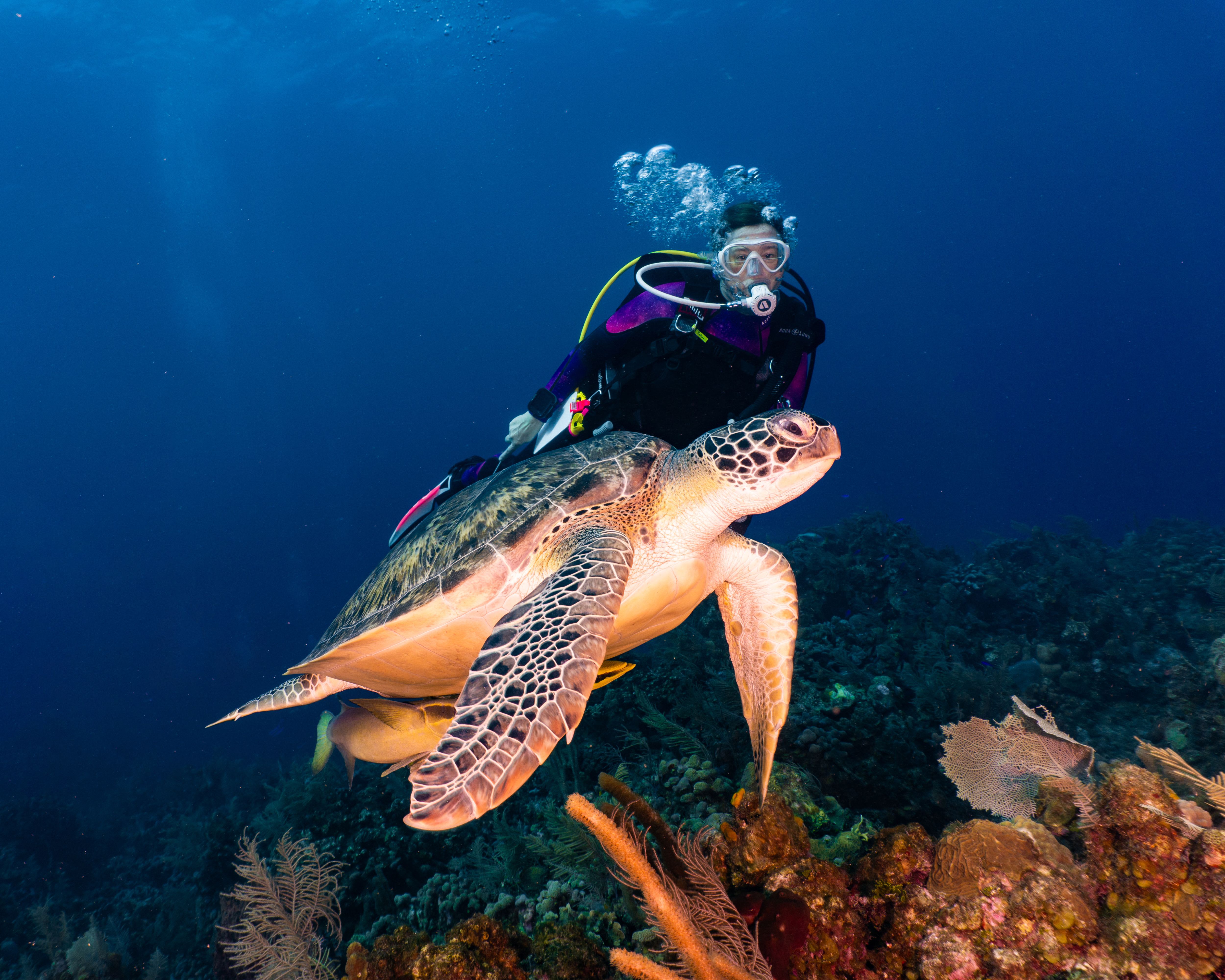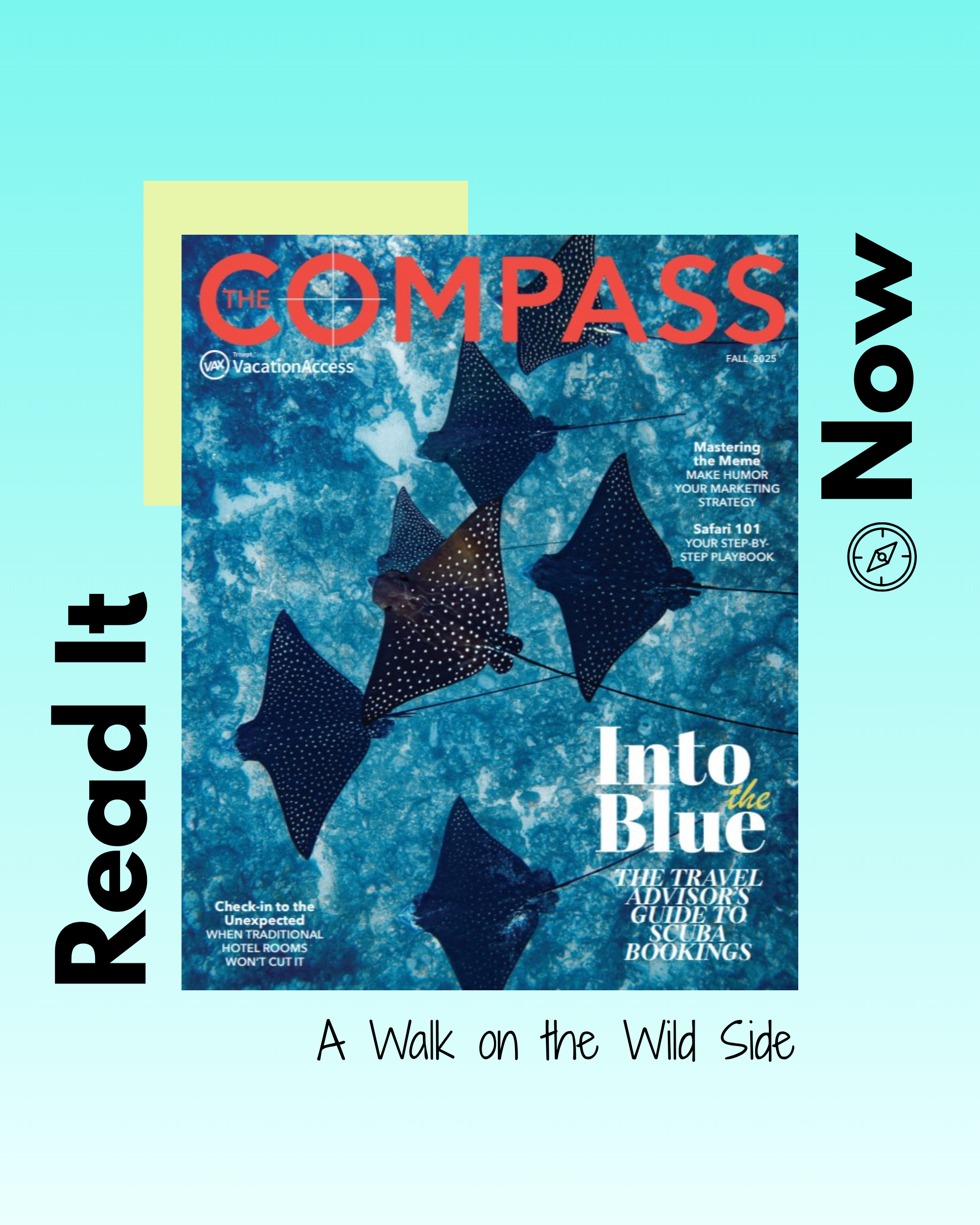There’s nothing quite like the thrill of scuba diving: slipping into a wetsuit and descending meter after meter into the depths of the ocean to swim alongside hammerhead sharks, whales, turtles, tropical fish, coral and even ancient ruins.
“You become part of that world,” Kleon Howe, founder of the Art of Travel, said. “No matter what age you are, it’s a very special experience.”
For some travelers, scuba diving may be a once-in-a-lifetime experience, but for many, including Howe and Robin Reiner, founder of Robin Wing Travel and a certified divemaster, it’s a lifelong adventure. As travel advisors and scuba enthusiasts, Kleon and Reiner are the pros. Here, they offer tips on booking guests at the best scuba locations around the world, including intel on which creatures can be found at each spot. Plus, they’ve even got some suggestions for what to pack. Let’s dive in.
Where To Go
A seasoned traveler since childhood, Howe has circumnavigated the globe in his sailboat “Rhiannon” and dove in destinations around the world. Nowadays, he specializes in helping scuba divers travel to the lush islands of the South Pacific. He’s still entranced by the magic of scuba diving, an adventure he likens to skydiving or taking a spacewalk.
For passionate divers to get the best experience, he recommended a “liveaboard” experience on a smaller boat, which takes divers to pristine areas far away from bigger boats and from other humans. “Liveaboard” means exactly what it sounds like, Reiner added: “It’s basically eat, sleep, dive.”
Dive centers at resort destinations will offer scuba experiences for divers of different levels. Look for criteria at each site indicating what level of experience your traveler needs to take the trip. For example, some destinations call for a minimum of 50 dives; others may demand divers have an advanced open water certification and corresponding experience, Reiner explained.
Whether you’re booking a newly certified diver or a seasoned pro, these destinations provide excellent options for getting into the water and finding a sense of awe.

For Beginners
Bonaire in the Caribbean Netherlands and Roatán in Honduras
These Caribbean islands are two of Reiner’s top picks for newbies, yet they still have plenty to offer more experienced divers. In Bonaire, travelers can easily scuba dive right off the beach in calm, shallow water at the “house reef.” It’s also a great spot for snorkelers with a vast fish population to discover. As for Roatán, Reiner described it as a “Caribbean treasure” for its immense barrel sponges. Along this massive Mesoamerican Barrier Reef that stretches along the coasts of Mexico, Belize, Guatemala and Honduras, divers will find vibrant and diverse marine ecosystems — and, of course, colorful fish.
For Wildlife Lovers
French Polynesia
A fringing reef wraps around this volcanic South Pacific destination, creating a lagoon between the reef and the main island. Large ocean waves break on that outer reef, leaving the interior waters mostly calm, Howe explained. Expect to see blacktip sharks, day glow fish and lemon sharks in the lagoon; in the cooler water of the ocean, divers may see hammerhead sharks, whitetip sharks and whales. Inside the reef is a great spot for beginners because there are no ocean waves, while more advanced divers can go inside the lagoon or out into the ocean, Howe added. Keep in mind that these dives will sell out in advance.
Fiji and Tonga
Floating, soft corals are a big draw to these South Pacific islands, Howe said. Beneath the crystal-clear waters, divers can spot tiger sharks and vibrant coral reefs. In Tonga, specifically, whales are a common sight. Reiner also recommended Fiji, especially if your client wants to dive with sharks. “Being able to see these species up close and personal was really pretty amazing,” Reiner said.
Maldives
Located in the Indian Ocean off the coast of Sri Lanka, this idyllic island chain with 26 atolls and more than 1,000 coral islands is among Reiner’s favorites. She recommended a liveaboard that makes a circuit around the islands to see what she describes as an “incredible variety of marine creatures with healthy corals.” Travelers can also dive with manta rays at their feeding stations and snorkel with whale sharks. It is recommended that divers have an “advanced open water certification, including Deep and Nitrox to accommodate safer diving for the four to five dives a day that are usual for liveaboards,” Reiner said. “It is also not uncommon to experience fast currents, which requires being able to know how to handle oneself.”
Great Barrier Reef
Howe describes this area off the coast of Australia as “lovely to dive on” with its vast array of rays, tropical fish, puffer fish and large pelagic fish. The Great Barrier Reef is composed of 900 islands and 2,900 individual reefs. It’s the largest coral reef system in the world, putting it at the top of many adventurers’ bucket lists.

For History Buffs
Greece, Italy and Turkey
Scuba diving may not be the first thing you think of when you think of this region, but it’s a fascinating spot to dive where travelers can see antiquities beneath the water. Specifically, Howe recommended Baiae, Italy, an ancient Roman port and resort city with submerged ruins of villas and temples. Pavlopetri in Greece on the Peloponnese peninsula is another popular spot, and is thought to be the oldest sunken city in the Mediterranean, with remains going back to 3000 B.C. As for Turkey, check out Dana Island near Mersin, which is home to a 3,000-year-old shipyard and ancient underwater city ruins. Keep in mind that these areas are in national parks and require the correct permits, so travelers should be sure to dive with known divers and diving centers.
The Philippines
The Philippines is known for its numerous shipwrecks, particularly in Coron Bay, Palawan and Subic Bay, making them popular spots for wreck diving, Reiner said. Many of these wrecks are from World War II, including Japanese supply ships and warships. The Okikawa Maru, Irako, Kogyo Maru and Olympia Maru are among the most famous wrecks in Coron Bay. In Subic Bay, the USS New York is a notable wreck, known for its large guns and propeller.
Tips for Booking Scuba Trips
- Certification, please. Be sure your traveler has had the necessary training to get their scuba certification before they go. Typically, that requires taking classes, practicing in a pool and doing some practice dives in the “wild” open water, Howe explained. Be sure to understand the diver’s comfort level before suggesting specific ideas.
- Know how to book. The Professional Association of Diving Instructors (PADI), the most-recognized dive training organization worldwide, has its own travel company, called PADI Travel, Howe said. Most inbound operators will book dives for advisors, he added, and suggested booking with Tahiti Travel Services, which works with dive centers in French Polynesia.
- Sort out dive insurance. Dive insurance through organizations like DAN and DiveAssure is a must, Reiner said. These programs are specifically geared for divers; in case of a dive accident, no other travel insurance covers it, she added.
- Look for truly sustainable travel options. As a biologist, former science teacher and advocate for the natural world, Reiner recommended booking sustainable travel. With specialized guides, travelers can get certified in coral restoration, research endangered turtles, tag sharks or even hunt lionfish, which are an invasive species in the Caribbean.
- Be careful with flight arrangements. Because of pressure concerns, make sure your diver has plenty of time between their dive and their flight. They’ll need at least 24 hours between coming to the surface on their last dive and taking their first flight, Howe advised.
- Don’t forget about the non-divers on the trip. Find out how much your client wants to dive, then plan accordingly. And if you’re planning a trip for a couple or a group with some people who want to dive and others who do not, make sure there are non-diving activities. Pro-tip: Many dive centers can take non-divers out snorkeling while the divers plunge deeper.
Originally appeared in the Fall 2025 issue of The Compass magazine







comments